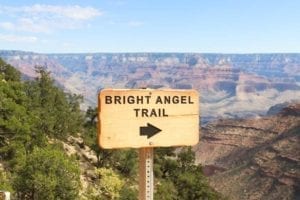A few years ago, I had an opportunity to hike down the Angel Bright Trail that takes people from the rim of the Grand Canyon to the base of the canyon. There were several interesting lessons from this hike. The first was experiencing the noise of the parking lot and trailhead. Lots of people milling around, not all intent on going down the trail. Once I committed to walking down the trail, the absence of noise was the first thing I noticed. As soon as I stepped off the rim, nature and quiet surrounded me and the noise of the rim was left behind.
As I walked down the trail, I soon realized that I could only see about two switchbacks ahead before the trail disappeared into the brush. Every once in a while, I could catch a glimpse of the trail in the distance, but those views were few and fleeting. As I continued to walk down the trail, the next switchbacks would appear, as if the trail was emerging as I walked down the path. I realized that my hike into the canyon was going to be an act of faith. I had to believe that the path existed and others before me also walked this “not fully seen” trail and got to their destination. My lesson that day was to learn to feel comfortable walking into the unknown.
Organizational Journeys: Defaults and New Habits
Much of my time as an organizational leader was taking paths that were fully seen. We were taught that good leadership and management meant that we would only start a journey if we could see all the implications, detours, construction zones, and the destination before we started the journey. To be effective, we only acted when the path was clear.
Today, leading organizations is much more ambiguous and volatile. We have wild cards showing up in our planning and implementation cycles because the disruptions from the outside environment are coming at us fast and furiously. This won’t slow down and poses the question: Can we continue to lead in times when our effectiveness will depend on our ability to walk down a path that is not fully seen, and a path where clarity only emerges as we move forward?
We are living in a time where our organizations are no longer bound and protected from our external environment. Our organizations are open systems and other systems, not under our control or influence, will bump into our organizations creating new variations and unexpected threats and opportunities. This means that our ability to scan the horizon and adapt to shifts quickly will be more valued than waiting until everything becomes clear.
Knowing your direction
Walking on a path that is unknown is not only difficult for leaders, it is also challenging to our employees. Employees often assess organizational leaders by the control and certainty they present when ambiguous and volatile situations arise. They want their leaders to remove their anxiety due to the unknown. Positional leaders need to resist this expectation because there will be times where organizational movement forward will require traveling into the unknown.
There is one other lesson that hiking down the Angel Bright Trail gives us for these times. The trail aligns with the direction we want to go. If we want to get to the bottom of the Grand Canyon, the trail offers a direction to achieve that end. Organizations have shifted their strategic planning language to strategic direction or strategic frameworks. This shift, like the Angel Bright Trail, provides a direction. You may not see the full trail but knowing the direction you want to head will lead you to your destination.
Dr. Kathleen E. Allen is the author of Leading from the Roots: Nature Inspired Leadership Lessons for Today’s World (2019) and President of Allen and Associates, a consulting firm that specializes in leadership, innovation, and organizational change. She writes a blog on leadership and organizations that describes a new paradigm of leadership that is based in lessons from nature and living systems at www.kathleenallen.net






